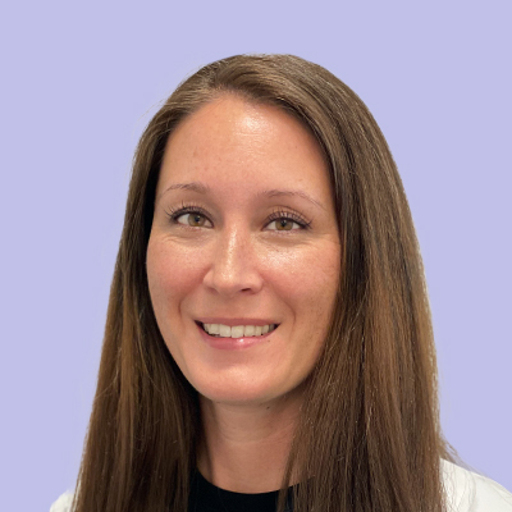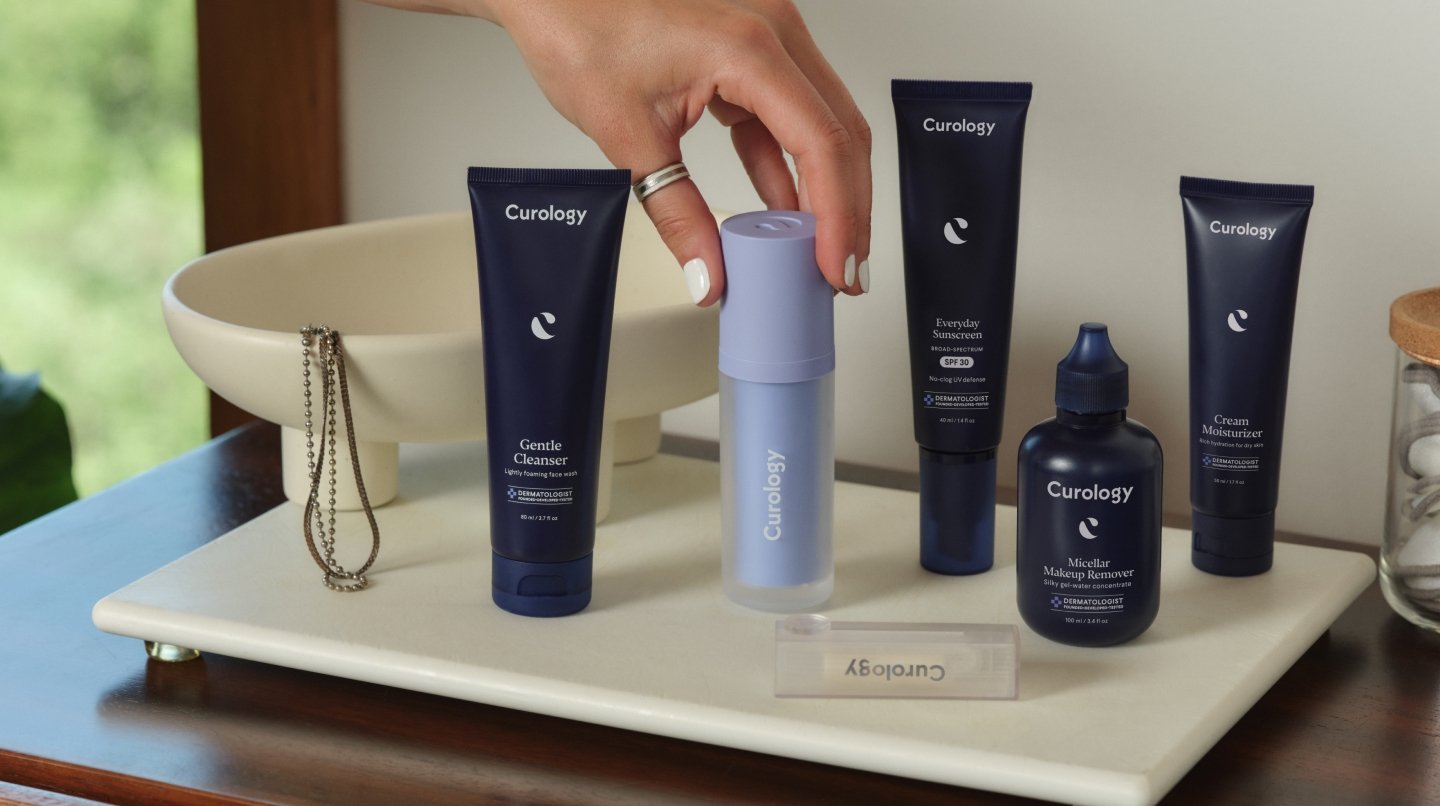How it works:
Share your skin goals and snap selfies
Your dermatology provider prescribes your formula
Apply nightly for happy, healthy skin
How it works:
How it works:
Share your skin goals and snap selfies
Your dermatology provider prescribes your formula
Apply nightly for happy, healthy skin
How it works:
Is there a helpful diet for adult acne?
Can avoiding “bad” foods really help acne?



Eating healthy provides essential nutrients for—yep!—healthy skin, but it doesn’t replace routine skincare. The two work together. That said, there’s no such thing as a truly “anti-acne diet.” But a healthy mix of fruits, veggies, and proteins can help boost skin health and stave off adult acne.
Acne forms when pores become clogged with sebum (the skin’s natural oil) and dead skin cells. Certain foods, such as sweets and skim milk, can create a chain reaction that culminates in excess sebum production, so eliminating those foods may help reduce breakouts. But effective skincare is also needed to help remove dead skin cells and other impurities.
Here we’ll explore which foods to eat, which you may want to avoid, and the role skincare plays in keeping adult acne at bay. We’ll also share contributing factors to acne and treatments that work to minimize and prevent breakouts. Plus, we’ll briefly describe the Whole30 diet and explain how it can be used to identify acne-triggering foods.
Four types of foods to support healthy skin
A nutritious diet provides essential nutrients the skin (and the body) needs. Exactly how food affects skin health is still under investigation, but research shows that inflammation plays a role. Foods with a high glycemic load, such as sugary treats, simple carbohydrates, and fast food, can increase inflammation in the body. This “invisible” inflammation can negatively affect skin health and contribute to acne.¹
Diets high in sugar and simple carbs also cause a spike in blood insulin levels. When insulin levels are too high, it creates a chain reaction in the body: High insulin levels increase inflammation and promote androgen hormone production, and androgens trigger oil production. Both inflammation and excess sebum contribute to breakouts.²
A 2014 study shows that low glycemic diets are associated with improvements in acne.³ Sounds simple enough—swap high glycemic foods for low glycemic index foods. But if your taste buds are used to sugary snacks, this can be harder than it seems. Here are some foods low on the glycemic index that will satisfy cravings:
Fruits, such as berries, plums, peaches, and cantaloupe, make a sweet treat and a good alternative to other options.
Most vegetables are low in carbs, but carrots, corn, beets, and sweet potatoes can add a bit of sugary goodness without the glycemic load.
Healthy grains, including barley, quinoa, and rolled oats, can be very satisfying with a dash of cinnamon for sweet-tooth cravings.
Lean meats, fish, eggs, and nuts are protein-rich foods. Although they may not satisfy a sugar craving, these foods are believed to be beneficial for collagen production. Collagen is one of the building blocks of skin tissue.⁴
We’re skincare experts, but we’re not dieticians. Our suggestions are based on common medical knowledge and current research, but we recommend consulting a dietician, nutritionist, or health care professional to learn more about reducing the glycemic load in your diet or adding supplements.
What is the Whole30 diet?
The Whole30 diet was created in 2009 to help reduce the effects of unhealthy eating within 30 days. It’s a nutritional “reset” to promote self-awareness of how food affects the body. The diet eliminates foods known to induce cravings, raise blood sugar levels, and detriment digestion and inflammation.
The Whole30 diet is similar to a traditional elimination diet. After 30 days, you’ll gradually reintroduce foods, paying attention to any bodily changes, such as digestive discomfort or skin conditions.
Calling it a diet is a misnomer because Whole30 is more about changing what you eat by monitoring which foods trigger adverse effects, such as acne. The Whole30 diet includes whole foods—vegetables, fruit, and protein—while avoiding processed foods, added sugar, dairy products, and alcohol. Here’s a list of what you generally can and cannot eat on the Whole30 diet:
What to eat on the Whole30 diet
Vegetables
Fruit (in moderation due to sugar content)
Unprocessed meats
Seafood
Eggs
Nuts and seeds
Ghee, olive oil, and coconut oil
Black coffee
What to avoid on the Whole30 diet
Dairy
Grains (corn, wheat, rice)
Legumes (chickpeas, lentils, soy)
Pasta
Bread
Processed additives
Added sugar
Alcohol
What contributes to adult acne?
Acne forms when pores become clogged with dead skin cells and sebum; the result is blackheads, whiteheads, inflammatory papules, pustules, nodules (or cysts), and acne scarring.⁵
These different types of acne are primarily concentrated in areas rich in sebaceous glands, including the face, neck, back, and chest.⁶ Certain factors can stimulate or exacerbate acne blemishes, including:
Hormones. Hormonal changes, such as those triggered by starting or stopping birth control pills, can lead to excess sebum production and hormonal acne.⁷ Hormonal acne is more prevalent during puberty, pregnancy, and menopause.
Genetics. A genetic predisposition and family history have been linked to adult acne.⁸
Diet. Inflammatory diets or diets high in simple carbohydrates and sugar can contribute to the development of acne.
Stress. Research has found a link between acne flare-ups and stress. The body produces more androgens under stress, which contribute to an overproduction of sebum.⁹ Stress during a breakout has also been shown to make acne worse.¹⁰
Skincare products. Many skincare ingredients are comedogenic—meaning they clog pores. People with oily or acne-prone skin may consider using oil-free products and should be sure that their products contain non-comedogenic ingredients.
Treatments for adult acne
The good news is that adult acne is treatable and there are steps you can take to help prevent it. Alongside a healthy diet, we recommend routine skincare, non-comedogenic products, and over-the-counter and prescription acne treatments.
OTC products that contain acne-fighting ingredients can treat and help prevent mild to moderate acne. Here’s what you need to know about some ingredients available at your local drugstore.
Azelaic acid is a gentle exfoliant that helps clear away dead skin cells and unclogs pores, helping treat and prevent acne. It can also help improve dark spots. Azelaic acid is available OTC, but stronger doses require a prescription.
Glycolic acid and lactic acid are alpha-hydroxy acids (AHAs). AHAs are chemical exfoliants that treat the superficial skin layer. They’re generally better for mild acne, whiteheads, and blackheads.
Benzoyl peroxide is an antimicrobial that targets acne-causing bacteria. This ingredient is common in facial cleansers and leave-on topical acne treatments. It can be found in our Acne Cleanser, which contains 2.5% benzoyl peroxide.
Salicylic acid is found in facial cleansers, creams, lotions, and gels. It reduces acne lesions by exfoliating deep into the pores to remove dead skin cells. The Acne Body Wash by Curology uses 2% salicylic acid to treat your body acne and is gentle enough to use every day.
Consider prescription treatments if you’re experiencing moderate to severe acne or your acne is ongoing. Here are some of our faves:
Topical antibiotics, such as clindamycin, are used to treat inflammatory acne. Clindamycin is often used with benzoyl peroxide to help prevent antibiotic resistance. The two pair well to treat and prevent acne.
Topical retinoids, such as tretinoin and tazarotene, treat acne and help prevent it from returning. Tretinoin is a vitamin A derivative that promotes skin cell turnover. Retinoids—whether OTC or prescription—can leave your skin photosensitive, so only use them at night and apply sunscreen during the day.
Oral medications, such as isotretinoin and oral antibiotics, are prescribed by a licensed medical provider to treat more severe forms of inflammatory acne that are not responding to topical treatments.
These treatments cannot replace a proper skincare routine and smart choices regarding skincare products. Here are some tips from our experts:
Wash your face at least once a day, but twice daily may be better. Use lukewarm water before applying a gentle cleanser for your skin type. Rinse with lukewarm water and pat dry using a clean towel or microfiber cloth.
Moisturize morning and night. Applying lotions or oils to an acne-prone face can seem counterproductive, but moisturizers protect the skin barrier.
Use non-comedogenic products and makeup. Skincare products and cosmetics can contribute to acne formation. Choose products with ingredients that don’t clog pores.
Wear sunscreen during daytime hours, regardless of whether you plan to step outside. Follow the American Academy of Dermatology guidelines: choose a broad-spectrum sunscreen with SPF 30 or higher. If you are outside, reapply every two hours.¹¹
We hope this article helps you understand how food can impact acne and provides some solutions to treat and prevent acne. Still, diet can only do so much, which is why we’re here to help.
Get your personalized skincare routine with Curology
Get your personalized skincare routine with Curology


Our complex lifestyles influence our hormones and—in turn—our skin, but acne solutions aren’t always one-size-fits-all. Curology’s licensed dermatology providers prescribe proven ingredients to create a personalized prescription formula to treat acne, signs of aging, and rosacea concerns.* Any time you have questions, just ask! We’re here for you.
FAQs
Maybe, and maybe not. Some research suggests that soy isoflavones reduce acne lesions. Soy isoflavones (a chemical component in soy) may have an anti-androgenic effect.¹² If our members love soy, we tell them to experiment with it. Because everyone is unique, some may experience breakouts while others may not.
We don’t. Despite our insatiable interest in research, we’re not dieticians. We have several articles on our blog covering dietary topics, including five foods that can trigger acne and the relationship between soy and acne, to help you learn more about diet and skin based on our research.
P.S. We did the homework so you don’t have to:
Tanghetti, E.A., The Role of Inflammation in the Pathology of Acne. The Journal of Clinical and Aesthetic Dermatology. (2013, September).
Melnik, B. C., et al. Over-stimulation of insulin/IGF-1 signaling by western diet may promote diseases of civilization: lessons learnt from laron syndrome. Nutrition & metabolism. (2011).
Mahmood, S.N., et al., Diet and Acne Update: Carbohydrates Emerge as the Main Culprit. Journal of Drugs in Dermatology. (2014, April).
Noguchi, A. and Djerassi, D. Chapter 15—Amino acids and peptides: Building blocks for skin proteins. Nutritional Cosmetics. (2009)
Kraft, J., Freiman, A. Management of acne. Canadian Medical Association Journal. (2011 April 19).
Makrantonaki, E., et al. An update on the role of the sebaceous gland in the pathogenesis of acne. Dermatoendocrinol. (January 2011).
American Academy of Dermatology. Adult acne. (n.d.).
American Academy of Dermatology. Adult acne. Ibid.
American Academy of Dermatology. Adult acne. Ibid.
Chiu, A., et al. The response of skin disease to stress: Changes in severity of acne vulgaris as affected by examination stress. Journal of the American Medical Association. (July 2003).
American Academy of Dermatology. Sunscreen FAQs. (n.d.).
Riyanto, P, et al. Advantage of soybean isoflavone as antiandrogen on acne vulgaris. Dermato Endocrinology. (January-December 2015).
Erin Pate is a board-certified Family Nurse Practitioner at Curology. She earned her Masters of Science in Nursing at Florida Atlantic University in Boca Raton, FL.
* Subject to consultation. Subscription is required. Results may vary.

Curology Team

Erin Pate, NP-C
Related Articles
Men skin care: top concernsHow to get rid of body and back acne?Sunscreen for eyes: How to protect your delicate skin from UV raysYour first weeks on CurologyWrinkles and other signs you’re doing it rightPopular Articles
Ask Curology: Is my cold breaking me out?Slugging: The dermatologist-approved skincare hack going viral on TikTokTretinoin vs retinol: What’s the difference?How to create a self-care routine that actually sticksYour 2023 skincare horoscopeTry prescription skincare
Get routine essentials

Good skin days ahead
- Breakouts
- Redness
- Fine lines
- Dark spots
- Hair thinning